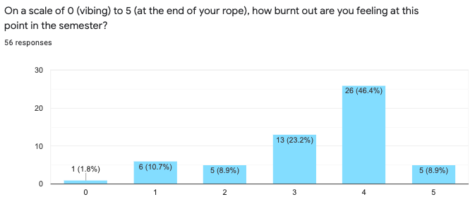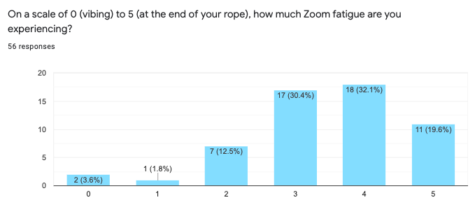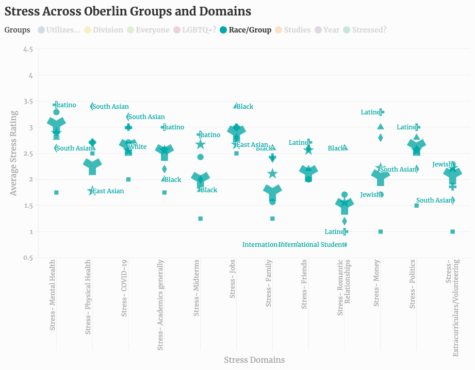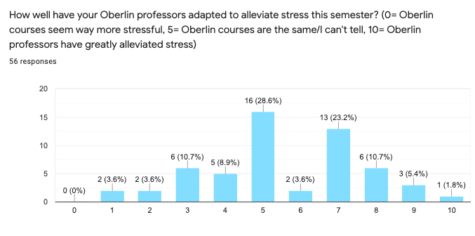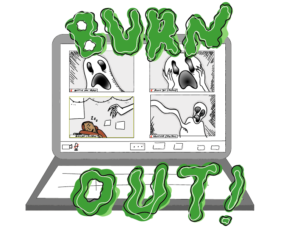The Numbers
April 9, 2021
Students were asked to rate their burnout and Zoom fatigue on a scale of 0–5, with 0 roughly defined as “vibing” and 5 as “at the end of my rope.” The average response was 3.44 out of 5, indicating high Zoom fatigue.
Students were also asked to rate their stress related to the following 12 issues: mental health, physical health, the COVID-19 pandemic, general academic performance, midterms, employment and internships, finances, politics, extracurricular activities/volunteering, and relationships — including familial, friendly, and romantic ones. For each domain, students had the option to choose not applicable, not concerned/doing well, slightly stressed, medium stress, very stressed, or personal crisis.
These scores were calculated on a five-point scale with personal crisis being “5,” unconcerned “1,” and N/A excluded. In doing so, we can compare means of stress across different domains by group. For example, below it can be seen that across race/group, Latino students (7) lead in stress regarding mental health, general academics, midterms, friends, money, and politics. Black students (5) lead in stress regarding jobs, family, and romantic relationships. South Asian students (5) lead in physical health and COVID-19 pandemic stress. Jewish students lead in extracurricular stress. Across all domains except physical health, international students (4) reported the lowest stress.
Students’ level of burnout varied depending on their identities, needs, and academic positions. People with academic/emotional accommodations (5), sociology students (7), and trans/nonbinary/genderqueer students (12) reported the most burnout. International students (4), and Conservatory students (2) reported the least burnout. Zoom fatigue can be observed via the color code, and groups can be isolated for comparisons.
Explore more below!
The answers “very stressed” and “personal crisis” were grouped together under “critical stress,” and “concerned/doing well” and “slightly stressed” were considered “less stressed.” This was done for the following stress categories: mental health, physical health, family, academics, and finances.
Students were asked on a scale of 0–10 “ How well have your Oberlin professors adapted to alleviate stress this semester?” with “0” defined as “Oberlin courses seem way more stressful,” 5 defined as “Oberlin courses are the same/I can’t tell” and 10 “defined as Oberlin professors have greatly alleviated stress.”
Areas of study have been defined as follows based on the self-reporting of respondents:
- Psychology (14)
- Sociology (7)
- Other Social Sciences (8, politics, economics, education studies, peace and conflict studies )
- STEM (19, Biology, pre-med, Physics, Chemistry, Computer Science, statistics, environmental studies, neuroscience )
- Music (6, conservatory musical performance, musical studies)
- Cultural Studies (15, Hispanic Studies, Africana Studies, Greek, GSFS, Comparative American Studies, Law and Society )
- Humanities (9, anthropology, English, history, philosophy)
- Creative Arts (9, creative writing, studio art, dance, cinema studies)
Students were asked to talk about majors, minors, and concentrations, which were not recorded differently. Psychology and sociology were isolated due to the numerous responses.
In the graph below, it is apparent that international students (4), humanities students (9), and those who are less stressed about academics (10) have the most positive opinion of professors’ ability to accommodate amid the pandemic. On the other hand, dual-degree students (2) , Jewish students (7), and those critically stressed about family (7) have the most negative opinion on the matter. You can explore all groups below, color-coded by average group burnout.


